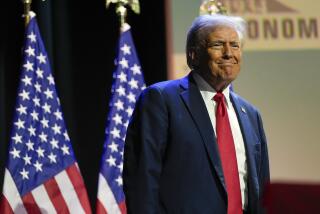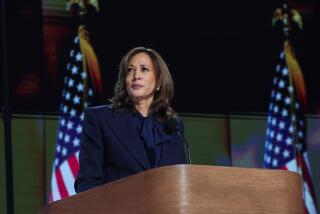POLITICS /HONEST ADS : Sponsors of Election Attacks May Be Forced Into Limelight
WASHINGTON â Without a magnifying glass, it might be hard to see who paid for the TV commercial attacking Republican Pete Wilson for dishonesty.
The crumb-sized picture of Democrat Dianne Feinstein, identifying her as the adâs sponsor, appears for only three seconds, fills just 0.8% of the screen and is hidden against the background of a newspaper.
But donât cry for Wilson. His gubernatorial campaign ad attacking Feinstein for allegedly favoring employment quotas is only slightly easier to identify. His fleeting picture fills 1.6% of the screen, but the written statement saying he paid for the ad is just as hard to read as Feinsteinâs.
PROPOSAL: Now the Federal Communications Commission is considering a petition that would require candidates to be more clearly identified with their ads. Some are hoping that the change might check the spread of negative and unfair attacks.
Filed by two interest groups, People for the American Way and the Media Access Project, the petition proposes that the government set standards for how big candidatesâ pictures and sponsorship statements need to be and how long they should appear.
It suggests that pictures fill at least 20% of the screen, that letters in the sponsorship statement be at least as tall as 4% of the screen and that both air for at least four seconds.
Now, federal regulations require simply that to qualify for the federally mandated discount given to political commercials, ads contain a picture of the candidate and a statement saying he or she paid for the ad. It is up to each TV station to decide whether the sponsorship is comprehensible.
The problem, People for the American Way argues, is that too often the candidate sponsorship statements are so fleeting and tiny they are meaningless, violating the spirit, if not the letter, of the current law.
âYou could blink and miss these,â said the groupâs president, Arthur J. Kropp.
DUAL GOAL: In addition to appealing to simple truth in advertising, the group hopes its proposal will inhibit vicious attacks.
âWith clearer identifiers, some of that mud so many candidates are slinging around is going to stick to them,â Kropp said.
Other proposals would go further.
Sen. John C. Danforth (R-Mo.) has offered legislation that would require that a candidateâs pictures fill 40% of the screen and that the candidate be required to announce: âI, (name), candidate for (whatever office), approved of this ad.â
Kathleen Jamieson, dean of the Annenberg School of Communication at the University of Pennsylvania, has suggested that the candidateâs picture fill the screen and that the message contain his or her name and regular campaign slogan.
Anything more modest is too easily thwarted, Jamieson argues. Among the usual sleights of hand, candidates can run pictures against moving backgrounds or have something dramatic occurring elsewhere on the screen.
âItâs a little like a magic trick,â Republican media consultant Eddie Mahe said.
OUTLOOK: First Amendment questions do not seem to be a problem, at least with People for the American Wayâs plan. Since the FCC already requires identification, even critics said guidelines making them readable only clarify existing law.
But most consultants also tend to think that the plan will have little impact.
âThe fact is, the most effective attack spots are comparative or issue based,â and already include the name of the sponsor clearly, Democratic consultant David Axelrod argues. âThe gratuitously nasty stuff backfires as much as it works.â
And some political professionals have problems with the more restrictive approaches, arguing that these would interfere too much with the message.
So far, no one has offered formal criticism of the idea to the FCC, and the Assn. of Broadcasters has filed favorable comments on the idea of guidelines.
Andrew J. Schwartzman, executive director of the Media Access Project, said he has gotten indications from people at the FCC that they are sympathetic to the idea of introducing guidelines. He also noted that FCC Chairman Alfred C. Sikes is a longtime friend of Danforth.
âNo one has the false illusion that this will be a cure-all,â Schwartzman said, âbut it is one small thing that something can be done about.â
More to Read
Get the L.A. Times Politics newsletter
Deeply reported insights into legislation, politics and policy from Sacramento, Washington and beyond. In your inbox three times per week.
You may occasionally receive promotional content from the Los Angeles Times.










